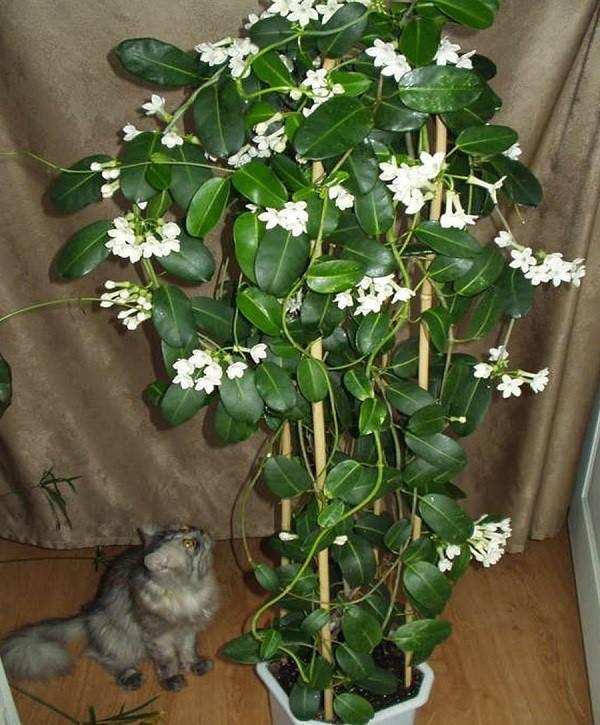Happiness flower stephanotis or Madagascar jasmine in our house
 Lovers of exotic indoor flowers, Stephanotis is well known as Madagascar jasmine. First of all, it's worth noting that they are not exactly the same thing. The name "stephanotis" means a separate plant species from the Lastovnevye family. There are about 16 of them, and almost all of them grow in natural conditions. These are semi-shrub vines with evergreen leaves and beautiful flowering.
Lovers of exotic indoor flowers, Stephanotis is well known as Madagascar jasmine. First of all, it's worth noting that they are not exactly the same thing. The name "stephanotis" means a separate plant species from the Lastovnevye family. There are about 16 of them, and almost all of them grow in natural conditions. These are semi-shrub vines with evergreen leaves and beautiful flowering.
In indoor conditions, most often only one variety of vines is grown - floribunda or profusely flowering Stephanotis. This species is also called Madagascar jasmine for its characteristic aroma of flowers.
Thus, madagascar jasmine is one of the varieties of stephanotis, most adapted to indoor conditions.
What does Stephanotis Floribunda look like?
Stefanotis Madagascar, like other representatives of this species, grows in the shape of a liana - its strong shoots can reach a length of up to 5 meters. Wax leaves up to 9 cm long and up to 5 cm wide flaunt on the branches all year round. They are dark green in color, very dense in structure and slightly pointed at the tips. They are located oppositely on the shoot.
At the beginning of summer, beautiful inflorescences appear on the liana: there are five slightly wrapped petals on a thin tubular leg, and the flower itself resembles a white crown on the leg (sometimes there is a cream color in the color). The total length of the flower reaches 4 cm, they are collected in inflorescences up to 7 pieces in each. In natural conditions, Stephanotis blooms almost all year round, but indoors the flowering ends with the arrival of autumn.
The inflorescences stay on the branch for a long time, and even after cutting they do not fade for a long time. Thanks to this, they are used to create flower arrangements, in particular, wedding bouquets.
After the end of flowering, in place of the inflorescences, fruits similar to plums are formed. When they are fully ripe, they burst. Inside the fruit are seeds in the form of small parachutes. When they get into a nearby flowerpot, they germinate and form a new plant.
What does Madagascar jasmine love?
When growing stephanotis, you should pay attention to the following points:
- The flower loves good lighting. This is especially important in winter, when the daylight hours are shorter. At this time, it may be necessary to install additional lighting. In the summer, the pot must be shaded so that direct rays do not fall on the plant, from which burns appear on the dark leaves.
- Jasmine needs to create a comfortable temperature: in summer it should not be higher than 25 degrees Celsius, and in winter the flower needs coolness (up to 15 degrees). This contributes to more lush flowering the next year.
- Watering should be regular, the soil should not be allowed to completely dry out. In addition, you should also frequently spray the leaves to maintain moisture. During the heating season, the flowerpot can be placed on a tray with pebbles.
- With the onset of spring (when growth processes are activated) and throughout the summer, jasmine should be fed twice a month with mineral preparations with a predominance of potassium. You can also use organic, but alternating fertilizers.
- Every year in March, it is necessary to cut the bush, and during the summer, pinch the tops of the shoots. Jasmine Madagascar blooms only on new branches.
- To give the flower a beautiful look and prevent damage to long branches, vines, you need to install a support. It can be either an arch or stretched ropes. It is better to lay branches while they are young and not lignified, since then this is very difficult to do.